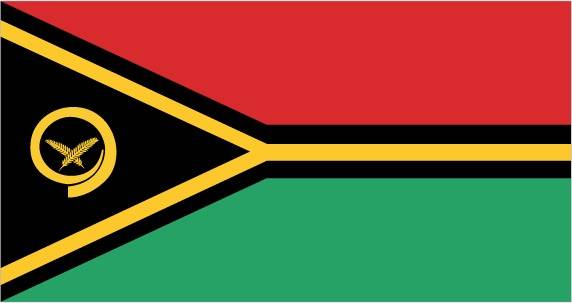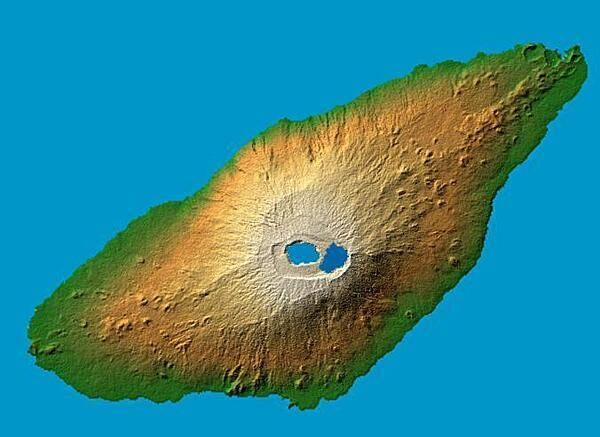53 Vanuatu

Two equal horizontal bands of red (top) and green with a black isosceles triangle (based on the hoist side) all separated by a black-edged yellow stripe in the shape of a horizontal Y (the two points of the Y face the hoist side and enclose the triangle). Centered in the triangle is a boar’s tusk encircling two crossed namele fern fronds, all in yellow. Red represents the blood of boars and men, as well as unity, green the richness of the islands, and black the ni-Vanuatu people. The yellow Y-shape – which reflects the pattern of the islands in the Pacific Ocean – symbolizes the light of the Gospel spreading through the islands. The boar’s tusk is a symbol of prosperity frequently worn as a pendant on the islands. The fern fronds represent peace.
Flag courtesy of the CIA World Factbook

Map courtesy of the CIA World Factbook

Periodically active volcano Mt. Manaro is the dominant feature in this shaded relief image of Aoba (Ambae) Island, part of the Vanuatu Archipelago located 2,250 km (1,400 mi) northeast of Sydney, Australia. The 1,496 m (4,908 ft) high Hawaiian-style basaltic shield volcano features two lakes within its summit caldera, or crater. Two visualization methods were combined to produce the image: shading and color coding of topographic height. The shade image was derived by computing topographic slope in the northwest-southeast direction, so that northwest slopes appear bright and southeast slopes appear dark. Color coding is directly related to topographic height, with green at the lower elevations, rising through yellow and tan, to white at the highest elevations.
Photo courtesy of the CIA World Factbook
Government
According to Britannica, under the terms of the 1980 constitution, the president, who serves as head of state in Vanuatu, is elected to a five-year term by an electoral college made up of the unicameral Parliament and the presidents of the Regional Councils. Members of Parliament are elected to four-year terms on the basis of universal franchise. Parliament elects the chief executive, the prime minister, from among its members; the prime minister then appoints a Council of Ministers. The constitution also provides for a National Council of Chiefs (Malvatumauri), composed of elected “custom chiefs,” which advises the government on matters relating to custom and tradition. Provincial authorities are responsible for local governmental functions.
The Supreme Court is the ultimate judicial arbiter of both civil and criminal matters. There are also a court of appeal and magistrates’ courts, and island courts may be established by warrant to rule on land disputes.
Civil Aviation Authority of Vanuatu
The Civil Aviation Authority of Vanuatu is a statutory body under the Ministry of Infrastructure and Public Utilities which oversees all aspects of the Republic of Vanuatu’s civil aviation system including regulating access to the 30+ airports and landing which provide critical aviation infrastructure to the country’s 65+ inhabited islands. CAAV’s mandated purpose is to ensure the safety of all people who engage in, benefit from or otherwise may be impacted by civil aviation within the nation’s sovereign airspace. This being the case, CAAV is also the primary regulator of autonomous flying drone operations within Vanuatu airspace.
Pacific Aviation Safety Office (PASO)
The Pacific Aviation Safety Office (PASO) is an international organization providing quality aviation safety and security service for Member States in the Pacific.
PASO is the sole international organization responsible for regional regulatory aviation safety oversight service for the 10 Pacific States who are signatories to the Pacific Islands Civil Aviation Safety and Security Treaty (PICASST).
The current PICASST signatories are the Pacific nations of Cook Islands, Kiribati, Nauru, Niue, Papua New Guinea, Samoa, Solomon Islands, Tonga, Tuvalu, and Vanuatu. Associate Members of PASO are Australia, Fiji and New Zealand. Government representatives from these nations make up the PASO Council.
Airspace
SkyVector – Google Maps – ADS-B Exchange
ICAO countries publish an Aeronautical Information Publication (AIP). This document is divided into three parts: General (GEN), En Route (ENR) and Aerodromes (AD). ENR 1.4 details the types of airspace classes they chose to adopt from classes A through G.
Drone Regulations
Advanced Air Mobility (AAM) Regulations & Policies
None found by the author.
However, should you, the reader, happen to stumble across something to the contrary, please email the author at FISHE5CA@erau.edu and you may be mentioned in the ACKNOWLEDGEMENTS section of this book by way of thanks for contributing to this free eBook!
Advanced Air Mobility (AAM) News
None found by the author.
However, should you, the reader, happen to stumble across something to the contrary, please email the author at FISHE5CA@erau.edu and you may be mentioned in the ACKNOWLEDGEMENTS section of this book by way of thanks for contributing to this free eBook!
Short Essay Questions
Scenario-Based Question
You have been hired by a Drone Startup Company. Your boss has immediately assigned this job to you.
They need you to prepare a one-page memo detailing the legalities of using a drone in Vanuatu.
They need you to mention any national laws and local ordinances.
They specifically want to know what airspace (insert pictures) you will be operating in and whether or not you need an airspace authorization.
Does it matter whether or not you are a citizen of the country?
Lastly, there is a bonus for you if, as you scroll through this chapter, you find any typos or broken links!
Short Essay Questions
- What are the drone categories?
- How is registration addressed?
- How is remote ID addressed?
- What are the model aircraft rules?
- What are the commercial drone rules?
- Are there waivers or exemptions to the rules? If so, for what?
- Would you share a link to an interactive airspace map?
- How is BVLOS addressed?
- How can you fly drones at night?
- How can you fly drones over people?
- Where do you find drone NOTAMs?
- What are the rules for drone maintenance?
- What are the rules for an SMS program?
- What are some unique rules not mentioned above?
- What are the C-UAS rules?
- What are the AAM rules?

